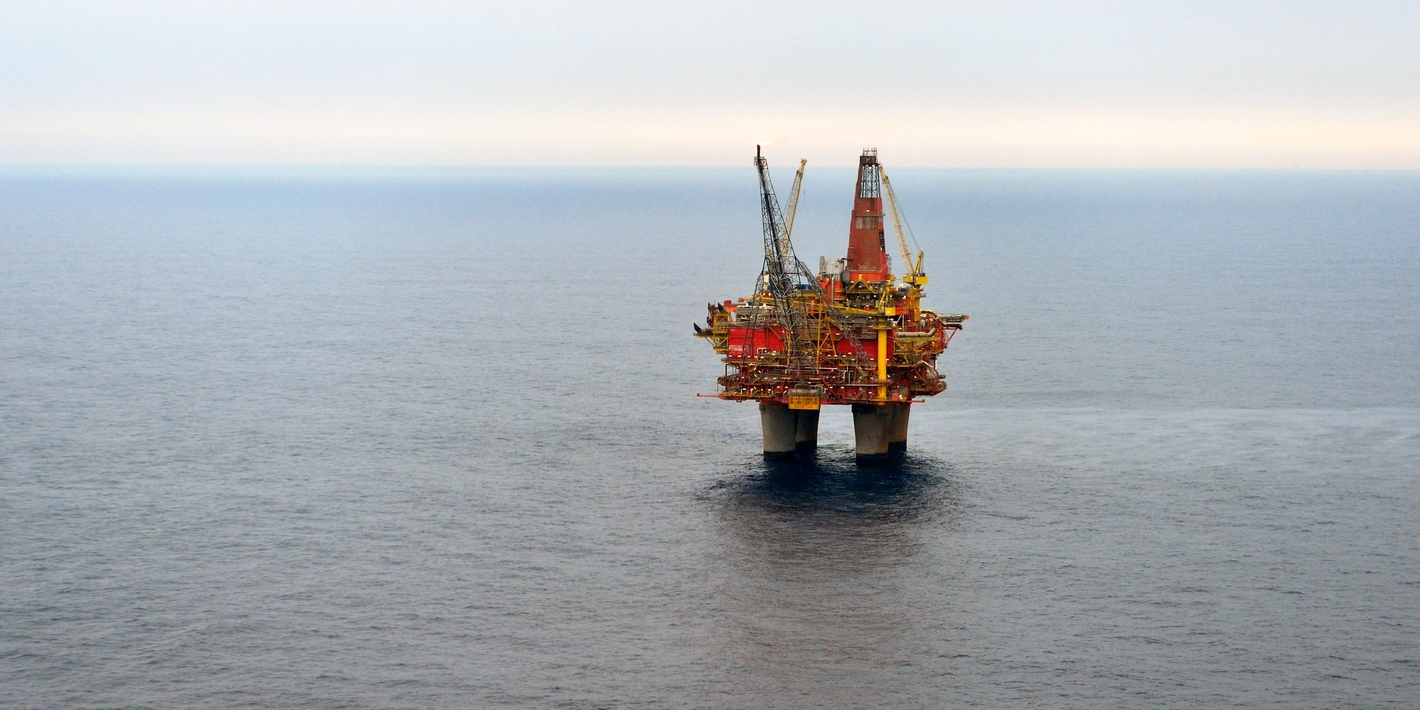Statfjord was discovered by Mobil in 1974, and then Statoil, now Equinor, took over the operatorship on 1 January 1987.
The field has been developed with the Statfjord A, B and C production platforms, which all have concrete gravity base structures incorporating storage cells.
Statfjord A
Began production on 24 November 1979.
Topside weight: 41,500 tons
Concrete substructure weight: 200,100 tons
Storage volume: 206,000 m3
Total height: 270 metres
Living quarters accommodate: 206 people.
Production start: 24 November 1979
Statfjord B
Followed on 5 November 1982, and Statfjord C on 26 June 1985.
The Norwegian share of the field lies in blocks 33/9 and 33/12 in production licence 037, while the British part is in UK block 211/25 in licences 104 and 293.
Statfjord is one of the oldest producing fields on the Norwegian continental shelf, and the largest oil discovery in the North Sea.
Oil and gas transport
Statfjord oil production is loaded into shuttle tankers on the field and shipped to a number of ports in north-western Europe.
The gas export, previously going via Statpipe to Kårstø, has since the startup of Statfjord Late-life in 2008 gone through Tampen Link and the FLAGS system to the St. Fergus gas terminal in Scotland.
Britain’s 14.53 per cent of the gas has since the startup of the Statfjord field travelsled by a separate pipeline via the NLGP pipeline to Scotland.
Cargoes are allocated between the field licensees in proportion to their interest in the respective licences.
Storage capacity
- The storage cells on the Statfjord A hold 206 000 standard cubic metres, 1.3 million barrels of oil
- The storage cells on the Statfjord B hold 302 000 standard cubic metres, 1.9 million barrels of oil
- The storage cells on the Statfjord C hold 302 000 standard cubic metres, 1.9 million barrels of oil
Oil and gas production
The hydrocarbon reservoir formations on Statfjord lie at depths of 2 500-3 000 metres. They consist of sandstones, with the oil and gas held in pores between the individual sand grains. These hydrocarbon-bearing sediments were all deposited in the Jurassic era, about 150 million years ago.
The production record for a single day on Statfjord was set on 16 January 1987, when 850 204 barrels were produced.
Roughly four million cubic metres of gas are exported daily by the Statfjord Unit.
Topside weight: 42,500 tons
Concrete substructure weight: 310,500 tons
Storage volume: 302,000 m3
Total height: 271 metres
Living quarters accommodate: 228 people.
Production start: 5 November 1982
Statfjord C
Topside weight: 50,000 tons
Concrete substructure weight: 290,000 tons
Storage volume: 302,000 m3
Total height: 290 metres
Living quarters accommodate: 345 people.
Production start: 26 June 1985
Area: The Norwegian share of the field lies in blocks 33/9 and 33/12 in production licence 037, while the British part is in UK block 211/25 in licences 104 and 293
Production: Oil and gas
Statfjord Nord
Statfjord Nord was discovered by Norskald in 1977 and lies in block 33/9.
Statfjord Nord, Statfjord Øst and Sygna are three satellite fields tied back to the Statfjord C platform.
Statfjord Nord lies about 22 kilometres north-east of Statfjord C, and has been developed with three subsea templates (D, E and F). These installations are tied back to Statfjord C with 10-inch flowlines. The D template is for water injection, while the other two handle oil production.
All installations on the field are subsea, and remotely operated from Statfjord C.
Location: Block 33/9
Production: Oil and gas
Statfjord Øst
Statfjord Øst was discovered by Norskald in 1977, and began production on 23 September 1994.
Statfjord Nord, Statfjord Øst and Sygna are three satellite fields tied back to the Statfjord C platform.
Statfjord Øst lies five kilometres north-east of Statfjord C, equally split between in production licences 037 in block 33/9 (Statfjord area) and 089 in block 34/7 (Snorre area).
Like the nearby Statfjord Nord field, this discovery has been developed with subsea installations tied back to Statfjord C by flowlines.
Statfjord Øst is provided with three subsea templates (K, L and M). The K structure is for water injection, while the other two handle oil production.
Location: Five kilometres north-east of Statfjord C
Production start: 24 September 1994
Production: Oil and gas
Sygna
The Sygna oil field is located in the north-east corner of the Statfjord area in the Norwegian North Sea.
It began producing on 1 August 2000.
Like Statfjord Nord and Statfjord Øst, Sygna is a satellite fiels tied back to the Statfjord C platform.
The Sygna field is, like Statfjord Øst, shared between the two production licences 037 (55 %) and 089 (45 %). The development solution embraces a subsea template, N, tied by a pipeline to the Statfjord C platform, which is 22 kilometres away.
Two production wells have been drilled through the template. In addition, water is injected into the reservoir through an extended-reach well drilled from the D template on the neighbouring Statfjord Nord satellite.
Location: In the north-east corner of the Statfjord area in the Norwegian Sea
Production start: 1 August 2000
Production: Oil
